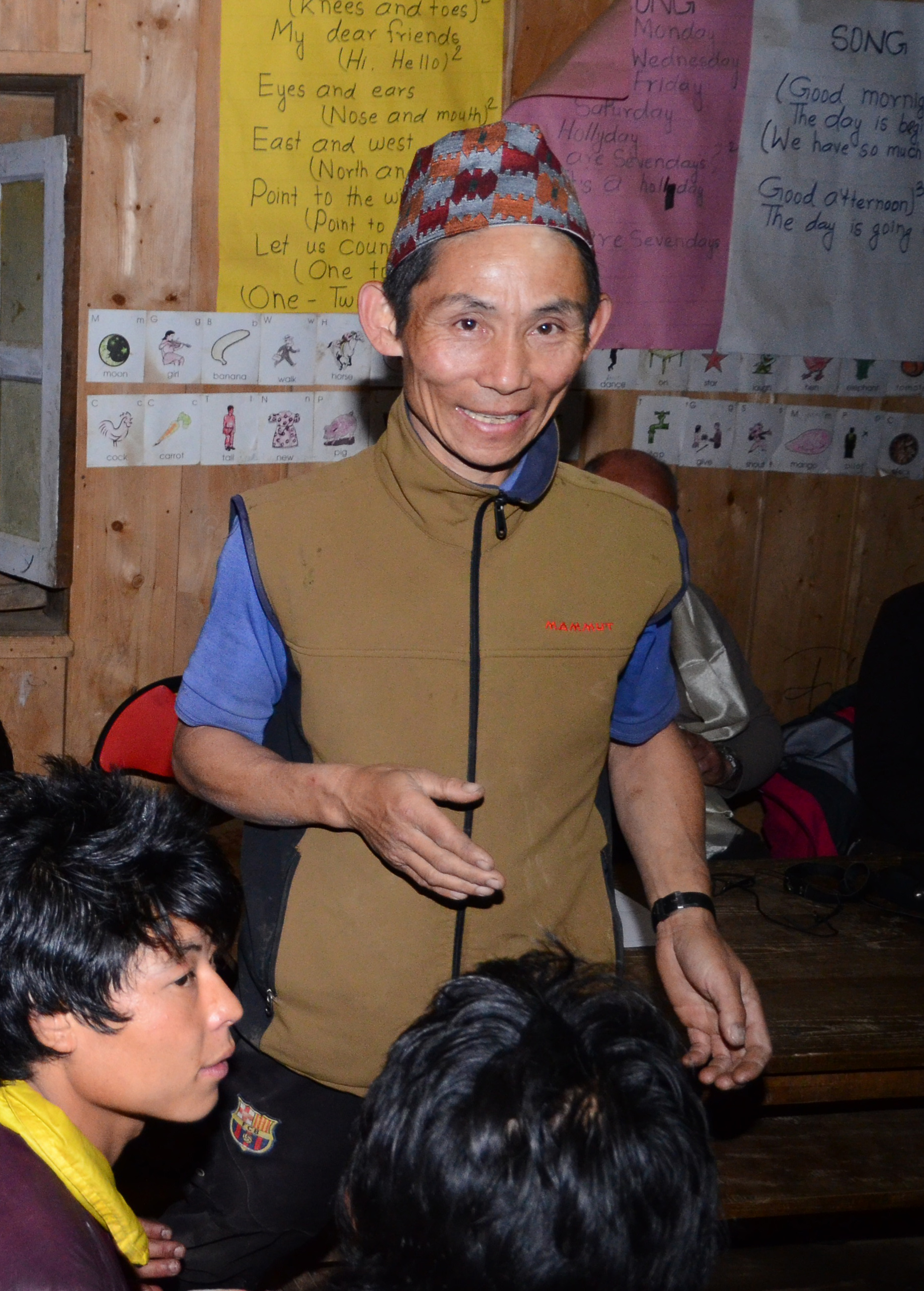Aananda Kumar Rai is 46, married and has 4 children aged 19, 17, 15 and 13. He is a farmer and runs a small shop near the college.
He is also Chairman of the Basa Kali High School Committee, after having been Chairman of the Forest Committee for a long time and an English teacher in the lower classes of the High School.
Aananda’s house, which he built next to Basa Kali High School (Yagachwai) three years ago, has been somewhat damaged, yet it has been classified as uninhabitable. He lived in a temporary shelter for a month and then returned to his house because life in this shelter was not practical.
I knew what an earthquake was from the radio, but also from a few small tremors I’d experienced over the last few years. It was all history. I never thought I’d experience the difficulties I did.
On 25 April I was with a friend and a child in the kitchen. Other friends were repairing the roof. Suddenly it moved and shook. At first I thought it was the people working on the roof. But then I fell into the kitchen. I heard screams and went outside with my friend and the child. The people on the roof jumped to the ground. It was moving vertically and horizontally and spinning like a cyclone. I heard a loud noise.
I’d sent my two sons to cut down trees for the roof. I thought there’d been a landslide and that they’d had an accident, that they’d died. I ran towards my children without realising that I had my kukri in my hand. The wall of the house I was running past broke just behind me. I found my two children. Dust swirled in the air. Opposite, on the other bank of the Dudhkosi, there had been a lot of movement. But here the houses weren’t badly damaged except for the old school buildings.
On 12 May, the weather was fine and the children were at school. When the earthquake hit, they screamed and those on the first floor started jumping over the railings, then the others went down the stairs. The main building swayed, like a seesaw. Fortunately, the strong roof structure was able to support the lauzes, which saved them, otherwise there would have been deaths.
Then the pupils gathered with their teachers in the playground, and the villagers arrived to get news of the children. Everyone knew what to do after the first tremor, including getting out of the classrooms. All day after that there were noises in the mountains, stones and rocks falling.
On the evening of the first tremor, we formed teams of 10 to 20 people who gathered at the homes of the nearest families. We got the animals out. We built shelters from things we’d salvaged from the houses and from bamboo. Here, in the school yard, there were 15 families. We collected food from the houses and we all ate together. We lived together. There were several aftershocks during the night. People were shouting and running. They talked to each other, remembering their parents’ stories. They looked for ways to protect themselves. But there were also rumours that there was going to be a magnitude 11 earthquake. We didn’t make any fires, but we did have electricity. We turned on the radios to get news from Kathmandu and elsewhere.
During the second earthquake, we had got into the habit of staying outside in temporary shelters. The tremor was very strong. Some people had returned to their houses, which had not been damaged after the first tremor. But this time there was a lot of destruction. People got out of their houses and built temporary shelters to stay in for longer. There was no school for a month.
During both earthquakes, police officers came to inspect and investigate.
My first instinct was to look for my children, to call them to gather in the school yard, to listen to the news, to get out what I needed and to build a shelter for the night. I can’t remember what my first words were because I was shocked. Afterwards, I think I said: “We have to get out of the houses”.
For Aananda, there are two types of explanation for these phenomena:
for teachers and educated parents, there is a scientific explanation, namely that Nepal is on a tectonic plate that is moving,
For the elderly, it’s God who’s angry because of dishonesty, lies, overpopulation, politicians who do their job badly and people who forget their traditions.
Life in the temporary shelters is difficult at the moment. The houses are damaged. Rebuilding them is expensive. There is no help from the government. The NGOs have not helped those who should have been helped. Today, it is difficult to know how to rebuild in order to save lives if there are further earthquakes. Life is hard.
When I think back on those moments, three ideas come to mind:
– I’m glad there were no deaths
– I ask God that there will be no more earthquakes or natural disasters
– but I’m afraid.
After the earthquakes, people thought differently:
– people in the lower part of Rapcha saw the cracks in the ground; they no longer want to stay there for fear of landslides in the monsoon; they are thinking of moving to higher ground or emigrating, which is not desirable
– people are thinking of (re)building smaller, single-storey, earthquake-proof buildings
– they want training in how to save their lives in the event of an earthquake
– for me, the priority is to rebuild the school in an earthquake-proof way, because if the school collapses, without this type of construction, many children will be killed.
For the future and for construction, I don’t think we should build just anywhere, anyhow. There have to be rules. The state must decide, help, advise with geologists (to know where to build, where to cultivate).
Marc Béchet


